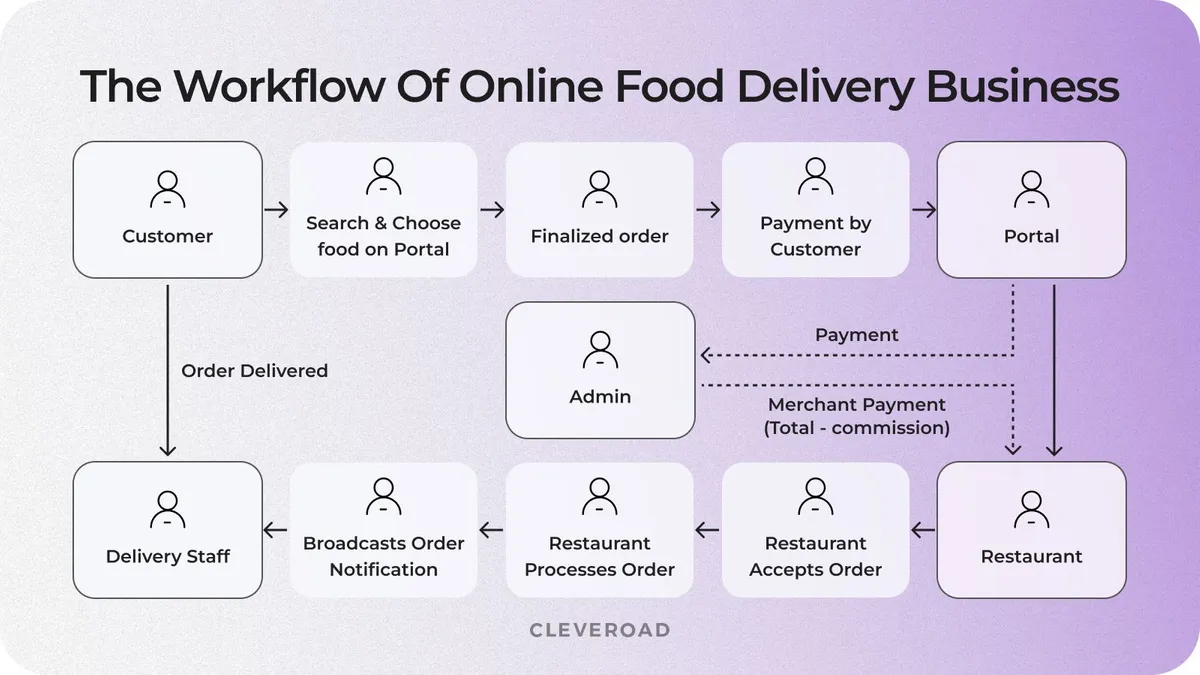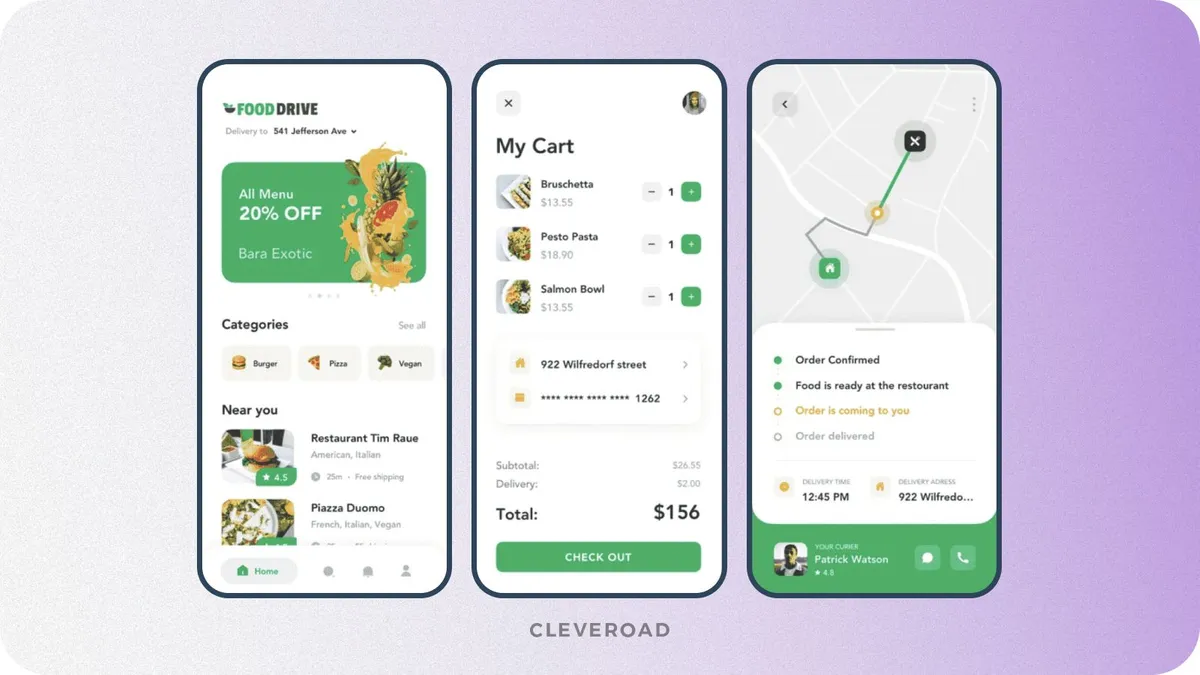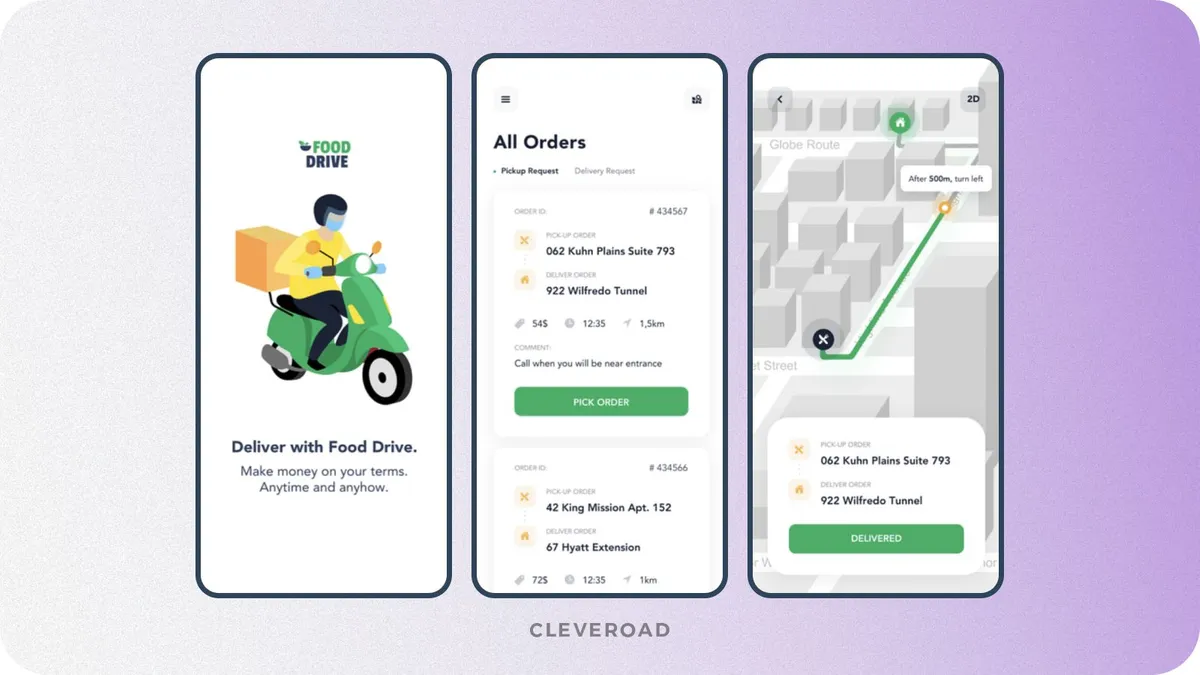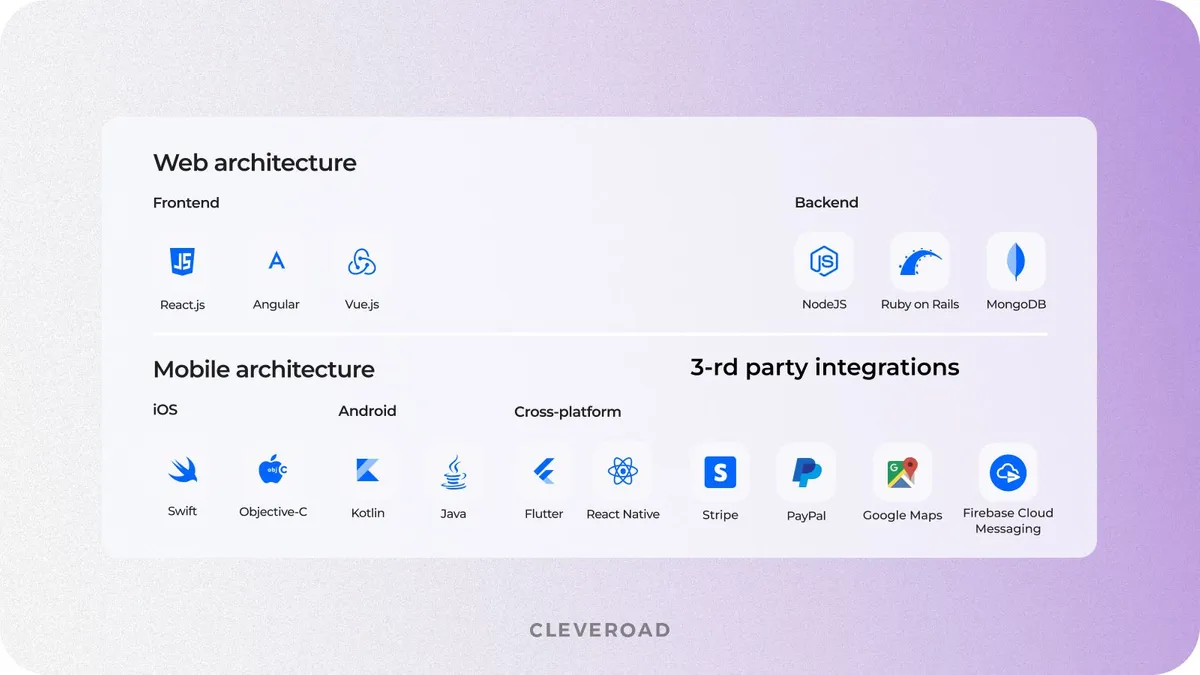How to Build a Food Delivery App: Features and Development Cost
Updated 09 Jul 2024
19 Min
3234 Views
Food delivery app development is an excellent way to start a competitive business and attract consumers who are increasingly opting for the convenience of having their meals delivered to their doorstep. However, food ordering applications are not as simple as they seem at first glance.
In this post, we will explore the process of developing a food delivery app in-depth, considering basic functionality, compliance tips, business architecture, and more.
How Food Delivery Application Works
A food delivery app is a digital solution that connects customers with local restaurants, streamlining the entire process of food ordering and delivery. Before diving into the technical considerations of how to create a food delivery app, let's explore the details of its business structure.
Business roles in food delivery app
To launch a delivery app that succeeds, you need to build a digital ecosystem with functionality for each user role. Here are the main business roles that need separate solutions to create a food delivery app similar to Uber Eats delivery model:
- Customer app. Users browse nearby eateries, view menus, place orders, and track deliveries in real-time. They receive updates on order status and can securely process payments.
- Restaurant app. Restaurants receive and manage orders, update their status, and prepare food. They can view order history, customer feedback, and performance metrics to optimize operations.
- Courier app. Couriers get notifications for delivery requests, navigate to pickup and delivery locations, and update order status throughout the process. Real-time tracking ensures transparency.
- Admin panel. Administrators manage the entire platform, overseeing user accounts, restaurant and courier onboarding, and customer support. They access analytics to monitor performance and implement promotional campaigns.
This set of apps will cover all aspects of your food delivery business. Sounds a little confusing, right? Let’s dive into the process and take a closer look at each of their tasks.
Food delivery app business architecture
Before we delve into the details of food ordering app development, let's take a closer look at the business logic and working mechanism of such apps to understand their functionality better:
- Getting started and ordering. Clients open the app, browse the available restaurants, and select one. They study the menu, select items, and order food.
- Restaurant notification. The restaurant receives a notification once the customer confirms the order and makes payment through the app. Staff receive the order information through the app's proprietary interface connected to the food delivery platform.
- Courier searching. Simultaneously, the app notifies nearby couriers (delivery drivers) of available orders. The courier accepts the order and heads to the restaurant to pick up the prepared food.
- Pickup and delivery. The courier uses the navigation system built into the app to find the fastest route to the customer's location. During the trip, the app tracks the courier's location in real-time and provides information to the customer and the restaurant.
- Completing order and reviewing. Upon arrival at the customer's location, the courier completes the delivery by handing over the food. The customer acknowledges receipt and can leave feedback or rate the service directly through the app.
Throughout the process, the app handles payment transactions securely. It subtracts the order cost from the customer's saved payment method, deducts a fee, and transfers the balance to the restaurant and courier accounts. Platform administrators oversee the entire process, ensuring smooth operations. They manage user accounts, handle disputes, optimize the app, and analyze data to improve efficiency and customer satisfaction.

How food delivery applications work
Basic Features to Create Food Delivery App
To create a food delivery app, you need to make four separate solutions for every business role. Each one requires a unique set of basic features necessary to ensure the platform's smooth operation. Let's review the functionality for all business roles in detail:
Customer app
The customer food delivery apps allow placing orders, making it a crucial part of the platforms. It is critical to create a delivery app with a user-friendly and attractive UI/UX design to satisfy your target audience's needs and attract more users.
The must-have features to develop a custom food delivery app for clients are:
Registration and login
Users can register and log in to your food delivery app effortlessly using either their email or phone number or through various social media platforms. Multiple login options, including Facebook, Google, and Apple Sign Up, increase accessibility and user registration. Ensure that password change and recovery features are readily available for user convenience.
Restaurant search
Create online food delivery app giving your customers an opportunity to search for nearby restaurants relying on their geolocation. It's hard to imagine an on-demand food delivery app without various filters to make the search process faster and more convenient. Also, you can add detailed information about restaurants so app users can learn more about eateries and choose where they prefer to order food.
Location tracking
To create a successful app, allow customers to track their orders in real-time as couriers pick them up using an integrated map feature. It would be also great if your food delivery mobile app would show the estimated delivery time. This functionality utilizes advanced location tracking technologies such as Google Location API for Android and Location Framework for iOS, ensuring accurate and seamless monitoring of delivery progress.
Order placement and payment
Make your own food delivery app with a simplified checkout process that is as simple as possible to decrease the number of abandoned orders. You can add payments via Braintree, Stripe, or PayPal. Such integration makes it easy for food delivery app users to pay for their orders. But keep in mind that these payment gateways charge fees. And don’t forget about the option to pay in cash.
Push notifications
Push notifications can help you remind users about delivery stages, such as acceptance, on its way, arrival, and so on, as on platforms like UberEats or Glovo. You can also send your customers various notifications about discounts or special offers. The best ways to develop push notifications would be:
- Amazon SNS
- Apple Push Notification Service (APSN)
- Firebase Cloud Messaging
Ratings and reviews
Feedback is an essential part of grocery delivery application development. It’ll help you see the gaps in your service and work towards its improvement. Make an option to leave a comment and rate the food and delivery process. To keep all feedback in a safe place, your team can use Microsoft Azure or AWS.

Customer app interface example of food delivery app designed by Cleveroad (Source: Dribbble)
Restaurant app
It’s all about accepting orders, getting notified, and managing menus. To make a food delivery app like UberEats for restaurants, you can focus on a web version or a native app installed on a kitchen tablet. Restaurant employees will use it to see incoming orders and notify courier when the order is ready.
The key features of restaurant app are the following:
Registration and login
This page is the gateway for authorized personnel to log into the platform securely. The registration process ensures that only authorized users can utilize the system.
Menu management
Restaurants should be able to adjust their menus so that users see up-to-date information when they decide to order. Otherwise, this may negatively impact both service and the restaurant’s reputation.
Order management
Restaurant staff needs to know all their incoming orders and work with them properly. With this feature, they can accept orders and change the order status.
Ratings and reviews
Let restaurant owners see comments and ratings, and don’t forget about the replying option. When discussing how to create a food ordering app, remember that communication with a customer is essential.
Creating food website additionally to food delivery app can help you increase online presence. Read our detailed guide explaining how to create food ordering website
Courier app
The delivery agent app for your restaurant should be simple, but its simplicity shouldn’t impact the smoothness of work. The courier should be able to use all the features on the go from a mobile device.
To achieve fast delivery, fill delivery person app with features like:
Registration and login
As with a customer app, make authorization fast and simple. Use different social media for authorization with Facebook SDK, Google SDK, or Sign in with Apple
Navigation
Provide the courier with convenient navigation through the city with the fastest routes and different destination marks (pickup address, delivery address, and so on). Your development team can use Google Maps Platform for Android and Location Framework for iOS.
Order detail and status
To understand how to start a food delivery app, it’s necessary to give the courier all order information, including precise meal content, customer address, and delivery time. Also, don’t forget about order statuses to let the courier accept or reject the orders.
Order history
Order history provides a detailed record of all deliveries completed by the courier. You can save all completed orders using cloud-based systems like Azure, AWS, and Digital Ocean.

Example food delivery app interface for courier created by Cleveroad (Source: Dribbble)
Admin panel
This is the command center of your business. All features here are created to manage information and to develop your business strategy.
Let’s dive into must-have admin panel features:
Admin login
This login screen typically includes an ID and password system, ensuring that only authorized personnel can access sensitive administrative functionalities.
Restaurant manager
This option will let your admin add different restaurants to the platform or manually delete them (for example, if customer ratings are too low or restaurants cease partnership with your app).
App analytics
With this feature, you can track important things like the most popular restaurants and sort them by profit, average check, etc. This information will give you a better understanding of the business and useful tips for better business development.
Payment management
With this feature included in the online food ordering app development, admins can change delivery fees. For example, you may want to reconsider fees for eateries bringing you a lot of orders to encourage them to use your delivery platform only.
Discount and coupon control
Offering discounts to users is an important strategy for encouraging existing users to order or attracting new ones. You can manage discounts based on different holidays and special occasions.
How to Make Your Own Food Delivery App in 8 Steps
Developing a food delivery app involves several stages and requires a clear understanding of the market, target audience, competitors, and business model. Let’s explore how to make an app for food delivery reviewing each step in detail.
Step 1. Validate your app idea
Before jumping directly into food ordering app development, you must validate your idea to ensure its success. Consider what solution you would like to create: do you want to build an app like Uber Eats or focus on a solution for a particular restaurant? Research the market to understand the needs and behavior of your potential users, collect customer data, and analyze trends. Evaluate your competitors to determine their strengths and weaknesses, and use this information to develop a strategy to differentiate your app from others in the market. This comprehensive validation process ensures that your app meets market requirements and has a competitive advantage.
Step 2. Select monetization strategy
Choosing the right monetization strategy is crucial for the success and profitability of your food delivery app. Selecting the appropriate monetization strategy will help ensure you develop food delivery app that not only meets your expectations for covering operational costs but also generates a steady income, making it a sustainable business model.
Here are primary monetization models you can consider:
- Restaurant fee. Charge restaurants a fee to be featured on the platform. This can be a fixed price or a percentage of each order, like Uber Eats' 15% fee. Restaurants can also pay extra for premium placement in recommendations or ads.
- User fee. Charge customers a delivery fee. It can be a fixed amount or variable based on delivery distance or time. For instance, Seamless charges a fixed $6 per order. Implement surge pricing during peak hours to increase delivery fees when demand is high.
- Commission from restaurants. This model involves charging restaurants a commission on every order placed through the app. The platform collects the payment from the customer, deducts the commission, and credits the remaining amount to the restaurant's account.
- Subscription model for merchants. Offer subscription packages for restaurants to register on your platform. Provide packages for individual restaurants and corporate chains with varying features and pricing. Merchants pay a regular fee to maintain their subscriptions and keep their restaurants listed.
You can choose any model that seems appropriate to your business goals or even combine several - for instance, implement a basic restaurant fee and supplement it with a subscription, allowing them to rank higher in search results.
Read our comprehensive guide explaining how to build on-demand delivery app to learn more about the profitability of this business model
Step 3. Choose an experienced IT partner
Once you have decided on the first requirements, you can hire a mobile app development company to create a food delivery app. You have several options to choose from:
Hiring in-house specialists. You can assemble your own team using local hiring platforms. This approach provides complete control over the process as the specialists will work under you. However, this option is costly in terms of time and money as it requires recruiting each team member, renting an office, equipment, and insurance payments.
Outsourcing. You can hire a team of specialists to build a delivery app from scratch. An outsourcing vendor provides access to qualified professionals, which reduces hiring time and app development costs because you avoid additional expenses and pay only for the work done. This approach frees you up for more important tasks as the vendor takes over full-cycle of product development.
Outstaffing. IT staff augmentation services allow you to hire only the staff you lack for a successful food delivery application development. You can reach to an outsourcing app development company and request specialists who will work as a remote part of your internal team.
Step 4. Decide on platforms and tech stack
Choosing a platform is an important step in developing a food delivery app. You need to decide whether your app will be native, web-based, or hybrid. Here is the specificity of each platform:
- Native apps are specific for mobile app development platforms (iOS, Android) and generally offer the best user experience and performance, but they can be more costly to build and maintain.
- Web apps run in a browser and don't require installation, making them more accessible, but they might have limited functionality.
- Cross-platform apps utilize a single codebase to achieve native-like performance across multiple platforms, balancing accessibility and development efficiency.
You can turn to cross-platform app development services if you want your food delivery service to cover multiple platforms. This option enables you to build an app for your food delivery service that works on several platforms with a single codebase, saving time and money.
Choosing a technology stack is also important to the success of online food ordering app development. It is important to select the programming languages, frameworks, databases, and other tools that will suit the needs of your food delivery solution. An experienced food delivery app developer can help you choose the right tools and technologies for your project.
Here is an example of the technologies that the Cleveroad team uses for food delivery applications:

Approximate tech stack for food delivery app development
Step 5. Create feature list
Creating a comprehensive feature list is critical in creating a food delivery app. This process involves identifying your app's functionalities to provide an exceptional user experience. Your vendor will help you start building your delivery app feature list by considering the core elements necessary for the app to operate effectively. Next, you can discuss how to enhance the user experience and differentiate your app from competitors to outperform them.
Your software provider will analyze your business goals and create a well-defined feature list as a part of Discovery Phase services. Then, they will use it to create an app development project timeline and budget estimations. This list will also guide the development process, ensuring all necessary components are included and aligned with your business goals.
Step 6. Think about UI/UX design
Outstanding UI/UX design is crucial to make your own food delivery app that attracts users. A well-designed interface ensures that users can easily navigate the app, find what they're looking for, and place orders quickly and simply.
UI/UX design services include developing an intuitive navigation system and clear visuals that help users easily navigate the app, from browsing the menu to placing an order. Branding is no less important - experts will create a design taking into account your corporate colors, logo, and fonts. This way, you will have a strong brand identity, increasing marketing effectiveness.
Step 7. Build a food delivery app
After receiving requirements and project specifications, developers build your food delivery app on the chosen platforms, whether iOS, Android, or cross-platform. They typically work in sprints, implementing a certain part of functionality during each one. Developing an app also includes integrating necessary APIs for features such as payment processing, GPS navigation, and push notifications to ensure seamless operation. Backend developers set up databases and server-side logic to allow the app handle data storage and processing efficiently.
The restaurant delivery app development process is also accompanied by quality assurance. QA engineers check every functionality to ensure it works seamlessly and has no bugs or critical errors. After the application is completed, they perform additional tests to make sure that your application can work under high loads and provide a smooth user experience.
Step 8. Release and promote your app
Once the food delivery app creation is complete, it's time to release it. Start by submitting the app to relevant app stores, such as the Apple App Store and Google Play Store, ensuring all app store guidelines are met for a smooth approval process. After the app goes live, implement a comprehensive marketing strategy to increase visibility and attract users. It can include social media campaigns, influencer partnerships, email marketing, and targeted ads. Use press releases and tech blogs to generate buzz around your app. Monitor user feedback and reviews closely to address issues promptly and improve user satisfaction. Effective promotion and continuous user engagement are essential for building a loyal customer base and driving app downloads.
Tips to Make Your Own Food Delivery App and Succeed
Creating a food delivery app involves more than just developing robust software; it requires careful planning, attention to regulatory requirements, and a focus on user satisfaction. Here are some key tips to ensure your app thrives in a competitive market:
Define your unique selling proposition (USP)
To make your own food delivery app stand out from the competitors, you need to define your unique selling proposition. First, it is important to analyze the existing food delivery market to understand what factors cause consumers' continuous intention to use online food delivery apps. Next, perform competitor research to identify gaps and opportunities to create a unique offering. Create app for food delivery that will satisfy the needs of a particular market segment, thereby giving yourself a competitive advantage. Focus on the uniqueness of your offering, whether it's special quality products, unusual types of cuisine, or personalized services.
Comply with food legal requirements
Food delivery app must comply with all necessary licenses and regulations for food industry to successfully launch and operate. Let's consider the most significant regulations to create food app:
- Food sale license. This category of requirements includes obtaining special permits for the sale of food products ensuring compliance with safety and hygiene standards in their processing, storage, and transportation. Examples: Food Sale License (USA), Food Hygiene License (UK), Food Product Sales License (Australia).
- Health and safety standards. These standards are aimed to ensure the safety of food products and include requirements for sanitation, food safety management, and temperature monitoring. Examples: HACCP System (EU), FDA Food Code (USA), Food Safety Standards (Canada).
- Personal data protection. This category of requirements includes obligations to protect users' data, including its collection, storage, and use. Examples: GDPR (EU), CCPA (US, California), PIPEDA (Canada), HIPAA (USA).
An experienced software vendor will help you analyze the regulatory landscape and build a food delivery app in compliance with all industry standards and local laws. Cleveroad specialists have deep expertise in creating software solution for food market complying with regulatory requirements.
Prioritize data protection
Food delivery apps collect and process sensitive personal information such as phone numbers, payment details, and home addresses, so you should create your food delivery app implementing robust data protection measures. At Cleveroad, we employ the following security measures:
- Data encryption on client devices and at rest
- Role-Based Access Control (RBAC)
- Data storage in certified cloud environments
- Security audits and vulnerability assessments
- Use of data anonymization or pseudonymization
Gather user feedback and improve
Collecting and incorporating user feedback is vital to continuously improving your food delivery app. Analyze user feedback in app stores to identify common problems and areas for improvement. Conduct A/B tests to compare app features and functions and determine what works best for your users. Implement a culture of continuous improvement, making regular changes to the app based on user reactions and market trends to keep it relevant and user-friendly.
How Much Does It Cost to Create a Food Delivery App?
How much does it cost to build a food ordering app? There is no universal answer to this question, since the final price depends on various factors, including development team’s location and expertise, project scope, platforms to cover, tech stack, etc. The cost of a food delivery app development also depends on the feature set and its complexity. The more features you want to implement, the higher the final price will be. We’ve made our own estimate based on the must-have features to build a food delivery app.
The estimate below is APPROXIMATE and based on the average hourly rate in Central and Eastern Europe ($50/h).
| Type | Hours | Cost |
User app for iOS and Android | 1,206 hours | $60,300 |
Courier app for iOS and Android | 914 hours | $45,700 |
Web-based solution for restaurants | 182 hours | $9,100 |
Web-based admin panel | 257 hours | $12,850 |
Total | 2,559 hours | $127,950 |
Please note that the estimate above is approximate and includes only the expenses to develop basic app version. The costs for UI/UX design, Project Management, and Quality assurance are not included and are calculated separately. Considering all the factors of food ordering app development, its final cost may range from $190,000 to $250,000+.
If you want to get an estimate considering all your requirements for food delivery application development, feel free to contact our specialists for consultation.
How Cleveroad Can Help You With Food Delivery App Creation
Cleveroad is a software development company with 12+ years of experience in creating digital solutions for restaurants, food chains, and catering services. We help businesses boost their performance and increase profits by providing full-scope IT services: mobile app development, web development, cross-platform app development, IT consulting, cloud development, UI/UX design, legacy software modernization, etc.
What benefits do you get by applying to Cleveroad?
- Access to proven technologies to build robust mobile and web applications, including Java, Kotlin, Swift, Objective-C, React, AngularJS, CSS, PHP, etc.
- ISO 27001-certified security management ensuring your food delivery app meets high standards of customer data protection
- Comprehensive quality management approved by ISO 9001 certificate to make your food ordering application stand out
- Flexible cooperation models to match your project needs: IT Staff Augmentation and Dedicated Development Team services
- Cross-platform app development services to speed up the development process and reduce food ordering app cost
- Free Solution Design Workshop to match your online food order app vision with technical implementation
- Experience in integrating food apps with helpful 3-rd party services, such as Stripe, PayPal, Twilio, Pusher, Google Maps API, Mapbox, Zendesk, Segment, Toast POS, etc.
As the business logic of food delivery apps aligns with on-demand software solutions, we want to share our experience in this field. Recently, our team created a P2P services providers marketplace called AYIO.
It's an innovative app that connects users with skilled professionals in various fields. The app features include a complex search engine that makes it possible to search by categories, real-time activity tracking, online service cost estimations, orders tracking, and history. A platform has a simple and intuitive UI/UX design to attract users and offer high performance.
Here is what our client Cohen Ben Frei, the founder of AYIO, says about cooperation with Cleveroad:


To make your own food delivery app just follow these steps:
- Research the competitors and define your niche (what is the most ordering food in your region).
- Come up with the features for your app. Keep up with the must-have features and consider adding extra features to your app.
- Work out your monetization strategy.
- Estimate the time and development cost. Developing companies provides estimations for your projects based on your ideas.
- After receiving an estimate, you can hire developers and start the development.
- Launch your app.
There are four possible monetization models for a food delivery app:
- Charging restaurants a fee to be placed on the app
- Charging customers a delivery fee
- Charging restaurants a commission on every order placed through the app
- Offering subscription packages for restaurants to register on your platform
The cost of online food delivery app development depends on a wide variety of factors, such as the number and complexity of features, UI/UX design complexity, software developers location and hourly rate, etc. Based on our experience, the cost to create a basic version of food ordering application takes about 3,800 - 5000+ hours and costs $190,000 - $250,000+ (based on $50/h).
Yes, food delivery apps can be profitable through commission fees from restaurants, delivery charges to customers, advertising partnerships, subscription models, and operational efficiencies. However, profitability varies based on market conditions and business strategies. Consider examples of well-known platforms: in 2023, Uber Eats reached a staggering $29.2 billion in revenue, and Glovo followed with $4.5 billion. Projections for 2024 are even more optimistic, with Uber Eats expected to reach $35.5 billion and Glovo expected to reach $3.0 billion.

Evgeniy Altynpara is a CTO and member of the Forbes Councils’ community of tech professionals. He is an expert in software development and technological entrepreneurship and has 10+years of experience in digital transformation consulting in Healthcare, FinTech, Supply Chain and Logistics
Give us your impressions about this article
Give us your impressions about this article
Comments
4 commentsOne of the best posts I have ever come across. Not only did I learn a lot of hidden things. Keep uploading and encouraging us.
Perfect Blog!! thanks to google for landing me here, food app development change food industry now people can order their favorite food online. and because of this every IT company is focusing on Food app development.
The very first challenge in restaurant app development is to gather information about features and functionalities. It’s always wise to proceed with a development partner, as a development partner knows the ins and outs of developing a robust and scalable app.
Hi Anton, The demand for food delivery app development is increasing day by day. The market has grown to the point where it currently has a multi-billion dollar market. In your article the list on map contains the biggest player in the food delivery world. You define the development process of food delivery app and its key feature as per customer, restaurant, management etc. Now I can optimize the cost and feature for food delivery app. Thanks for sharing this article.